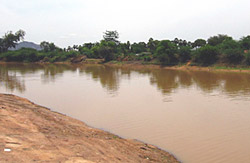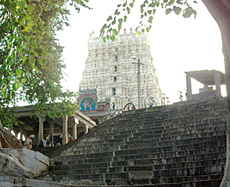 Ambasamudram is a municipality in the district of Tirunelveli in the Indian state of Tamil Nadu. According to the census of 2001 Ambasamudram had a population of 32,681. The picturesque town of Ambasamudram is actually situated in the foothills of Western Ghats on the northern bank of River Tamirabarani. The twin town of Ambasamudram, called Kallidaikurichi or Kallidai is situated on the southern bank.
Ambasamudram is a municipality in the district of Tirunelveli in the Indian state of Tamil Nadu. According to the census of 2001 Ambasamudram had a population of 32,681. The picturesque town of Ambasamudram is actually situated in the foothills of Western Ghats on the northern bank of River Tamirabarani. The twin town of Ambasamudram, called Kallidaikurichi or Kallidai is situated on the southern bank.
This town is also famous for a number of tourist attractions including the Manimuttar Dam, a half-mile long dam held on three sides by mountains, which is also regarded as a picnic spot. The there is the Karaiyar Dam. One can see the scenic beauty of this place from the boat ride in Karaiyar Dam, which is simply superb. Another tourist attraction is the Tamirabarani River, which also originates from a peak in the hills of Western Ghats above Papanasam in the taluk of Ambasamudram and flows through the Tirunelveli and Tuticorin district. Karaiyar Dam has year round moderate temperature to befit the requirements for bathing and swimming. The other popular tourist spot is the Agasthiyar Falls, which has a religious significance attached to it and after bathing in the water of which is believed to relieve one from all the sins committed in his whole life.
 As the southern part of India is famous for its temples and shrines the town of Ambasamudram also boasts of many famous temples. The geographical location of this town is such that it has protected the temples from all the foreign invasions and this has helped in the maintenance of the originality of the shrines. Though in the recent times most of these temples are on the verge of destruction still they are renowned all over the Indian subcontinent for their artistic, historical and religious value. One of the famous temples of Ambasamudram is the one constructed for Saint Agasthiyar or Agastya. One can reach this temple by trekking a distance of 3 kilometers. The Mannar Kovil Temple of Ambasamudram is one of those few shrines with andashtanga vimana`. On the ground floor of this temple has a sanctum for Lord Vishnu standing with his two consorts. A narrow flight of steps leads to the place where he is sitting with his consorts. The Papanasam temple is situated near the Agasthiyar Falls and it is believed by the people of this region that after taking bath in this river, going to the temple is alleged to grant you relief from all the sins committed by one his lifetime. The other temple called Brahmadesam is believed to have been constructed during the reigns of Raja Chola. Regular buses are available which will make one reach the desired destination in a short time. The region of Ambasamudram also has a rich and glorious culture. The Hindu festival of Tai Pusam is observed here with much vigor and enthusiasm. A bath in the sacred river is considered to be very meritorious on this day and the people from the remotest corners of the state flock to this place to celebrate the festival with much pomp and show.
As the southern part of India is famous for its temples and shrines the town of Ambasamudram also boasts of many famous temples. The geographical location of this town is such that it has protected the temples from all the foreign invasions and this has helped in the maintenance of the originality of the shrines. Though in the recent times most of these temples are on the verge of destruction still they are renowned all over the Indian subcontinent for their artistic, historical and religious value. One of the famous temples of Ambasamudram is the one constructed for Saint Agasthiyar or Agastya. One can reach this temple by trekking a distance of 3 kilometers. The Mannar Kovil Temple of Ambasamudram is one of those few shrines with andashtanga vimana`. On the ground floor of this temple has a sanctum for Lord Vishnu standing with his two consorts. A narrow flight of steps leads to the place where he is sitting with his consorts. The Papanasam temple is situated near the Agasthiyar Falls and it is believed by the people of this region that after taking bath in this river, going to the temple is alleged to grant you relief from all the sins committed by one his lifetime. The other temple called Brahmadesam is believed to have been constructed during the reigns of Raja Chola. Regular buses are available which will make one reach the desired destination in a short time. The region of Ambasamudram also has a rich and glorious culture. The Hindu festival of Tai Pusam is observed here with much vigor and enthusiasm. A bath in the sacred river is considered to be very meritorious on this day and the people from the remotest corners of the state flock to this place to celebrate the festival with much pomp and show.



















